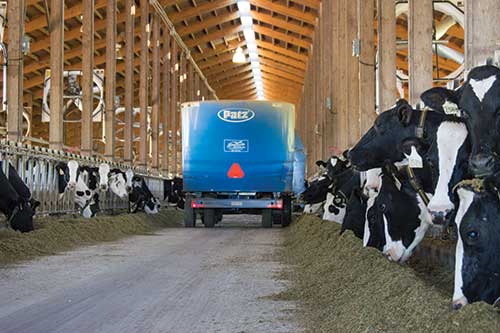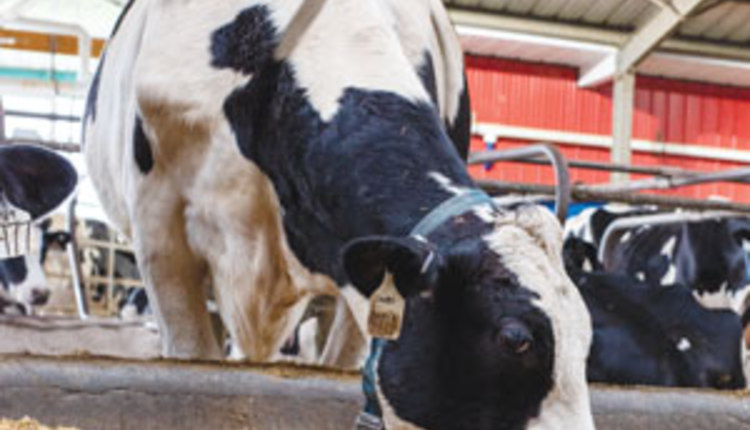The author is an associate professor at the University of Guelph, Kemptville.

Only when we deliver a consistent ration and cows consume it according to plan will we be able to maximize our ration's potential, resulting in optimal production and efficiency.
Dairy producers are continually challenged with ensuring consistent and balanced nutrient intakes in their cows to promote health, productivity and production efficiency. In theory, a TMR is formulated so that producers are confident they are providing a well-balanced diet. Unfortunately, the formulated TMR is not the only ration found on most farms. We also need to consider the TMR that is delivered, consumed and digested by the cow.
Drastic differences observed
In recent research, we have observed that, as the variability between these "rations" and the formulated ration becomes greater, so does the chance that cows will not perform to expectation. While most of us have always suspected that cows do not always receive the ration exactly as it is formulated, this research is some of the first to support this idea and identify the potential consequences.
For our study, we sampled the mixed and delivered TMR on 22 freestall, parlor-milked herds for seven consecutive days in the winter and summer months. The nutrient analysis on these feed samples was then compared to that formulated "on paper." Across farms, the average TMR fed did not accurately represent that formulated by the nutritionist.
The average TMR delivered exceeded formulations for energy, nonfiber carbohydrates, acid detergent fiber, calcium, phosphorous, magnesium and potassium. Crude protein, neutral detergent fiber and sodium were underfed. Theoretically, overfeeding might not be problematic as a safety margin is generally included in formulation to account for uncertainty in ingredient composition. Across farms, however, there was a huge range in this variation, with some farms consistently experiencing a 5 to 10 percent discrepancy (both positive and negative) between the fed and formulated ration for nearly all nutrients.
Physical characteristics vary most
We also investigated the day-to-day consistency in physical and chemical composition of TMR and how this impacted productivity. Greatest day-to-day variability was observed for refusal rate, particle size distribution and trace mineral content. Delivery of a more consistent ration was associated with improved production.
As an example, greater dry matter intake, milk yield and efficiency of milk production were all associated with less daily variability in energy content of the ration. Lower daily variability in percentage of long forage particles was associated with greater milk yield and efficiency of milk production.
It is interesting to note that, on average, day-to-day variability was greater for physical characteristics (particle size distribution) of the ration compared to nutritional composition. Even though this study was not designed to identify the factors that contribute to this variability, this would suggest that this day-to-day variation may have been caused by variability in feed component nutrient and dry matter composition. In addition, mixing errors probably played an even larger role.
Regardless, these findings suggest that additional surveillance of the TMR composition, in addition to individual feed ingredients, may be helpful as a regular component of your feeding strategy. Further, this data reinforces the need for standard feed protocols and training.
Say we get the TMR right and consistently deliver it as formulated. It does not mean cows will eat that ration. It is well established that cows will typically sort for the grain component and against the longer forage components. Previous research by our group has shown that such sorting can lead to individual cows consuming an inconsistent ration. It also puts cows at risk of experiencing depressions in rumen pH and production of milk with a lower milkfat percentage.
Sorting undermines your ration
Our recent field study has provided further evidence for the potential negative impacts of sorting. Less sorting, at the herd level, against long forage particles was associated with better production (fat- and energy-corrected milk) as well as greater efficiency of milk production.
Given these impacts, strategies to reduce feed sorting are, thus, imperative. While there are several dietary approaches to this (changing forage particle lengths, using less dry forage, adding water to dry TMR), work by our group and others has also shown the importance of feeding management in reducing sorting.
For example, delivering TMR twice per day or more often, as opposed to once per day, has consistently shown reduced sorting at a group level. One of the benefits of providing TMR more often is not only having cows consume a more consistent ration but also consume that ration in a manner which promotes better rumen digestion.
Cows fed more frequently typically have more frequent, smaller and slower meals throughout the day. This results in a more consistent input of nutrients, in time and composition, into the rumen. While previous research has shown that this typically results in improved fiber digestibility, rumen efficiency and milkfat production, our research has also shown that this may translate into production benefits. Feeding twice per day, as opposed to once per day, was associated with 6 percent greater milk yield in our field study.
Another feedbunk management decision to consider is the targeted refusal rate. More sorting is observed in those herds feeding for higher refusal rates. Basically, the more feed you put in front of cows, the greater their ability to pick through that feed and get what they want. This suggests that feeding for a low refusal amount may not only have economic benefits associated with reduced feed wastage but may also promote consumption of a diet closer to that intended.
The question then becomes how low can you go? In an ideal world, you would like to target as little refusal as possible, without leaving cows with an empty bunk for any significant period of time. Researchers have shown that, when cows are limited in their time to access feed across a day, they will negatively modify their consumption patterns, particularly in situations of overcrowding.
In our field study, we found that every 4-inch reduction in bunk space per cow (across a range of 14 to 38 inches per cow) was associated with producing milk 0.06 percentage points less fat. This is likely due to the impact that crowding at the feedbunk has on the feeding patterns of cows.
Overall, it is important that dairy cows consume the right ration, that is, the one that is formulated for them. To achieve this, that feed must be delivered to cows on a consistent basis and consumed as it is delivered and in a manner which is good for them.
Click here to return to the Nutrition E-Sources 140810_489

Dairy producers are continually challenged with ensuring consistent and balanced nutrient intakes in their cows to promote health, productivity and production efficiency. In theory, a TMR is formulated so that producers are confident they are providing a well-balanced diet. Unfortunately, the formulated TMR is not the only ration found on most farms. We also need to consider the TMR that is delivered, consumed and digested by the cow.
Drastic differences observed
In recent research, we have observed that, as the variability between these "rations" and the formulated ration becomes greater, so does the chance that cows will not perform to expectation. While most of us have always suspected that cows do not always receive the ration exactly as it is formulated, this research is some of the first to support this idea and identify the potential consequences.
For our study, we sampled the mixed and delivered TMR on 22 freestall, parlor-milked herds for seven consecutive days in the winter and summer months. The nutrient analysis on these feed samples was then compared to that formulated "on paper." Across farms, the average TMR fed did not accurately represent that formulated by the nutritionist.
The average TMR delivered exceeded formulations for energy, nonfiber carbohydrates, acid detergent fiber, calcium, phosphorous, magnesium and potassium. Crude protein, neutral detergent fiber and sodium were underfed. Theoretically, overfeeding might not be problematic as a safety margin is generally included in formulation to account for uncertainty in ingredient composition. Across farms, however, there was a huge range in this variation, with some farms consistently experiencing a 5 to 10 percent discrepancy (both positive and negative) between the fed and formulated ration for nearly all nutrients.
Physical characteristics vary most
We also investigated the day-to-day consistency in physical and chemical composition of TMR and how this impacted productivity. Greatest day-to-day variability was observed for refusal rate, particle size distribution and trace mineral content. Delivery of a more consistent ration was associated with improved production.
As an example, greater dry matter intake, milk yield and efficiency of milk production were all associated with less daily variability in energy content of the ration. Lower daily variability in percentage of long forage particles was associated with greater milk yield and efficiency of milk production.
It is interesting to note that, on average, day-to-day variability was greater for physical characteristics (particle size distribution) of the ration compared to nutritional composition. Even though this study was not designed to identify the factors that contribute to this variability, this would suggest that this day-to-day variation may have been caused by variability in feed component nutrient and dry matter composition. In addition, mixing errors probably played an even larger role.
Regardless, these findings suggest that additional surveillance of the TMR composition, in addition to individual feed ingredients, may be helpful as a regular component of your feeding strategy. Further, this data reinforces the need for standard feed protocols and training.
Say we get the TMR right and consistently deliver it as formulated. It does not mean cows will eat that ration. It is well established that cows will typically sort for the grain component and against the longer forage components. Previous research by our group has shown that such sorting can lead to individual cows consuming an inconsistent ration. It also puts cows at risk of experiencing depressions in rumen pH and production of milk with a lower milkfat percentage.
Sorting undermines your ration
Our recent field study has provided further evidence for the potential negative impacts of sorting. Less sorting, at the herd level, against long forage particles was associated with better production (fat- and energy-corrected milk) as well as greater efficiency of milk production.
Given these impacts, strategies to reduce feed sorting are, thus, imperative. While there are several dietary approaches to this (changing forage particle lengths, using less dry forage, adding water to dry TMR), work by our group and others has also shown the importance of feeding management in reducing sorting.
For example, delivering TMR twice per day or more often, as opposed to once per day, has consistently shown reduced sorting at a group level. One of the benefits of providing TMR more often is not only having cows consume a more consistent ration but also consume that ration in a manner which promotes better rumen digestion.
Cows fed more frequently typically have more frequent, smaller and slower meals throughout the day. This results in a more consistent input of nutrients, in time and composition, into the rumen. While previous research has shown that this typically results in improved fiber digestibility, rumen efficiency and milkfat production, our research has also shown that this may translate into production benefits. Feeding twice per day, as opposed to once per day, was associated with 6 percent greater milk yield in our field study.
Another feedbunk management decision to consider is the targeted refusal rate. More sorting is observed in those herds feeding for higher refusal rates. Basically, the more feed you put in front of cows, the greater their ability to pick through that feed and get what they want. This suggests that feeding for a low refusal amount may not only have economic benefits associated with reduced feed wastage but may also promote consumption of a diet closer to that intended.
The question then becomes how low can you go? In an ideal world, you would like to target as little refusal as possible, without leaving cows with an empty bunk for any significant period of time. Researchers have shown that, when cows are limited in their time to access feed across a day, they will negatively modify their consumption patterns, particularly in situations of overcrowding.
In our field study, we found that every 4-inch reduction in bunk space per cow (across a range of 14 to 38 inches per cow) was associated with producing milk 0.06 percentage points less fat. This is likely due to the impact that crowding at the feedbunk has on the feeding patterns of cows.
Overall, it is important that dairy cows consume the right ration, that is, the one that is formulated for them. To achieve this, that feed must be delivered to cows on a consistent basis and consumed as it is delivered and in a manner which is good for them.










